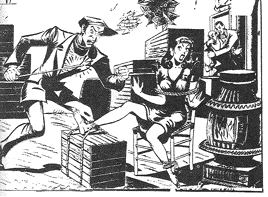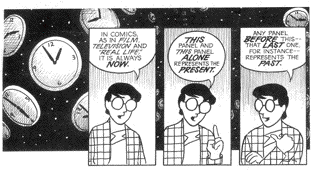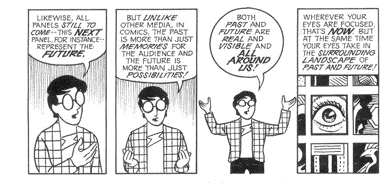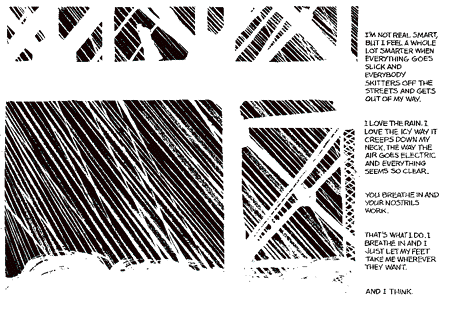graphic_novel
According to the now legendary story, comic book artist and writer Will Eisner first linked the words 'graphic' and 'novel' in 1978. Eisner used the term 'graphic novel' to describe a number of his comic book tales collected under a single title, forming a book-length publication. Eisner's creative word-play failed to convince the publishers to whom he first offered his work, yet the designation 'graphic novel' has since entered the lexicon of literary genres (Weiner 17). The Oxford English Dictionary currently carries a definition of 'graphic novel': "a full-length (esp. science fiction or fantasy) story published in comic-strip format" (OED).
Eisner likely invented the term in order to distinguish his new work from comic books, artifacts of popular culture with a long history of stigmatization for their alleged less-than-edifying content. Most notable is the attack on the American comic book industry in the 1950's, significantly propelled by Frederic Wertham's Seduction of the Innocent (1954, Fig. 1), during which the government took a serious look at the content of comic books and other popular culture media. Eisner was no doubt familiar with comic book criticism. An acknowledged master of the art, Eisner worked on comics in some form until his death in 2005.

Figure 1. Comic book illustration reproduced in Seduction of the Innocent with caption: "Children told me what the man was going to do with the red-hot poker."
Like the OED, most try to define 'graphic novel' in terms of attributes relative to comic books. For example, graphic novels are described as longer or sturdier than the average comic book. Graphic novels are said to cost x% more than comic books. Critics debate whether the term implies certain content: can an anthology of comics be considered a graphic novel, or does a work have to be envisioned and published as a graphic novel to be one? Furthermore, does a graphic novel have be about a subject worthy of serious consideration, such as the holocaust or coming of age, or can they be about superheroes, elves, and supernatural beings?
The most essential definition of 'graphic novel' will not be predicated on issues of size, shape, cost or content. Rather, a definition of graphic novel should consider the implications of linking the words 'graphic' and 'novel' to describe this specific medium.
Storytelling and the Novel
In Narrative and Graphic Storytelling, Eisner writes that "the story is the most critical component in a comic . . . the intellectual frame on which all artwork rests" (Eisner, 1996 2). In this sense, all comics can be considered novels - even the single panel cartoon or comic strip; the defining characteristic of a novel is not length, but the realism of storytelling. "The fundamental aspect of the novel," argues E.M. Forester, "is its story-telling aspect" (Forester 44). Forester describes the story as the "backbone of a novel," the perpetually ticking clock that propels our page turning: "we want to know what happens next." According the Forester, time inside the novel is undeniable; time allows for experience, the essence of a novel's realism. A 300-page comic book is not necessarily more of a "graphic novel" than a four panel Peanuts strip (Fig. 2) because each displays Ian Watt's definition of formal realism: "the premise, or primary convention, that the novel is a full and authentic report of human experience" (Watt 32). Both Eisner's A Contract With God (1978) and any given Charles Schultz creation convey the "primary criterion" of truth to individual experience that the novel embodies (Watt 13).

Figure 2. Peanuts, October 2, 1950.
Individual experience, writes Watt, "is always unique," thus the novel is "the logical literary vehicle of a culture which, in the last few centuries, has set an unprecedented value on originality . . . it is therefore well named" (Watt 13). 'Novel' implies the originality that writers have brought to the medium of comic books, seeing the potential for their innovative stories to make a greater impact within single publications rather than through an extended series of comic issues. In other words, the rise of the graphic novel in the latter half of the 20th century and into the next corresponds to an increase in the demand for fresh approaches to the communication of individual experience.
A consideration of the term 'graphic novel' cannot avoid referencing, to some extent, the variety of narrative types published in the last twenty years. In Maus (Pantheon Books, 1987), Art Spiegelman relates the story of his father's survival as a Jew in World War II Nazi Germany, in addition to illustrating his own experience composing a graphic novel on the difficult subject. Watchmen and Batman: The Dark Knight Returns (both DC Comics, 1986), each place the well-known 'superhero' narrative within a postmodern historical setting in order to focus on the psychological intricacies of their less-than-invincible protagonists. Graphic novels like Dan Clowe's Ghost World (Fantagraphic Books, 1998) and Jimmy Corrigan: the Smartest Kid on Earth (Fantagraphics, 2000) by Chris Ware offer contemporary impressions of the 'coming-of-age' tale though their visually compelling formats. The list of successful graphic novels grows exponentially each year, yet as the medium advances in popularity, it retains originality as its main impetus for developing stories.
Time and Space Through Sequential Art
Paul Ricoeur writes that "two kinds of time are found in every story told: on the one hand, a discrete, open, and theoretically undefined succession of incidents (one can always ask: and then? and then?); on the other hand, the story told presents another temporal aspect characterized by the integration, the culmination and the ending in virtue of which a story gains an outline" (427). Graphic novels convey both the linear and narrative formations of time through the 'sequential art' that is unique to the comic book format.
Novel storytelling is combined with the sequential art of the comic book to create the graphic novel. Scott McCloud, in Understanding Comics: the Invisible Art, defines comics as "juxtaposed pictorial and other images in deliberate sequence, intended to convey information and/or to produce an aesthetic response in the viewer" (McCloud 9). Likewise, Eisner designates comics as a "sequential art," referring mainly to the artist's task of arranging "the sequence of events (or pictures) so as to bridge the gaps in action" (Eisner, 1985 38). The story of a graphic novel is told through a progression of frames, technically referred to as 'panels.' Panels "secure control of the reader's attention and dictate the sequence in which the reader will follow the narrative" (Eisner, 1985 40).
Comic book panels are comparable to the frames of a film, or images on a television screen; as McCloud suggests, "In comics, as in film, television, and 'Real Life,' it is always now. This panel and this panel alone represents the present. Any panel before this - that last one for instance - represents the past. Likewise, all panels still to come - this next panel, for instance - represent the future" (McCloud 104, (Fig. 3)).

Figure 3. McCloud, Understanding Comics: 104.
However, in film, television, and photography only one frame is available at a time for the viewer's consumption. In sequential art, McCloud writes, "the past is more than just memories for the audience and the future is more than just possibilities! Both past and future are real and visible all around us! Wherever your eyes are focused, that's now. But at the same time your eyes take in the surrounding landscape of past and future!" (McCloud 104 (Fig. 4))

Figure 4. McCloud, Understanding Comics: 104.
Time in the sequential art of the comic book is a distortion of how time is experienced in human understanding. St. Augustine envisioned the three forms of time - past, present, and future - as contemporaneously related: "The time present of things past is memory; the time present of things present is direct experience; the time present of things future is expectation" (Augustine Book XI). Augustine's conception of time is opposed to the eternal presence of God, who is capable of experiencing past, present, and future simultaneously. Under human understanding, "all time is forced to move on by the incoming future; that all the future flows from the past; and that all, past and future, is created and issued out of that which is forever present" (Augustine Book XI). As Patrick Maynard argues, photography, like sequential art, forces us to think about the arrangement of time within seemingly motionless and momentary depictions of space. The difficulty, in photographs and comic books, is determining what degree of time is represented by the single comic book frame or photographic image: "For example, if we attempt . . . to picture time as a one-dimensional flow . . . with "now" as an index that-like the photofinish razor slit-cans, that strip as "now" shifts to ever later times - we have the awkward situation that, since all times get indexed as "now" . . ., to identify the present we'd need to know where the "now" index was . . ." (Maynard 208).
It remains ambiguous whether we experience comic book frames as a series of 'nows,' instantaneous moments, like snapshots of frozen actions, or as a continuous stream of movement comparable to the fusion of frames that compose the movie-viewing experience. How comic books are read, or consumed, is a direct function of the exclusivity of sequential art.
Also unlike the frames of other media, the comic book panel must be exclusive; film and television displays continuous action, yet the comic book contains only a fraction of that continuous action within its panels. The exclusive nature of the comic book panel forces the sequential artist to be fully aware of how a story is to be laid-out - movies may be composed scene-by-scene, or even shot-by-shot, but comic book storytelling is depicted frame-by-frame. Marshall McLuhan notes that the exclusivity of depiction in the comic book affects the method of its consumption. McLuhan writes that the modern comic strip and comic book "provide very little data about any particular moment in time, or aspect in space, of an object. The viewer, or reader, is compelled to participate in completing and interpreting the few hints provided by the bounding lines" (161). Like television, which McLuhan notes also has a "very low degree of data about objects" in its "mosaic mesh of dots," the comic book requires the participation of the reader (161). For McLuhan, comic books and television both have a "participational and do-it-yourself character" (165).
Graphic Storytelling
Graphic novels combine text and pictures equally in order to convey a narrative. Both words and images are essential to the graphic novel, thus creating the desire for compatible relationships between visual representation, through talented art and design, and dialogue or descriptive writing. W.J.T. Mitchell writes extensively on the associations and connections between words and images, noting that "the domains of word and image are like two counties that speak languages but that have a long history of mutual migration, cultural exchange and other forms of intercourse" (49) (see the entry on the comic book for further discussion words and images as language). In the successful graphic novel, words and images should be on equal planes, one should not be privileged over the other. One cannot ask of a graphic novel, "which is more important, the words or pictures?" as both the domains combine to form an inseparable text (Fig. 5).

Figure 5. A panel from Frank Miller's Sin City demonstrates the ability of words and pictures to cooperatively form a coherent text.
Jan Baetens writes that words and pictures are two types of language: verbal and visual. Pictures organized within comic book panels must be perceived as a whole text if a story is to be conveyed to the reader. Through a model of what Baetens calls "relatedness," the panels of a graphic novel are "related to one another so as to form . . . a unified whole" (Saraceni 167). In graphic novels, the 'text' is formed by the sequence of panels; panels are identical to the sequence of sentences in a text of just words; " - sentences and panels represent the most identifiable units into which language-based texts and comics are respectively arranged" (Saraceni 169).
The reader's progression through the pages of a graphic novel is a function of the sequential artist's ability to convey "real life through the spatial perception of time and space" consistently through the comic book panel. As mentioned above, both the past and future of a story are represented simultaneously on the pages of a graphic novel. Consequently, the sequential artist must depend on the reader's conditioned response to the written word in order to communicate a coherent story. McCloud notes that, fortunately, "comics readers are also conditioned by other media and the "Real Time" of everyday life to expect a very linear progression. Just a straight line from point A to point B" (McCloud 106).
Ricoeur explains the process of reading as a process of transfiguration which takes place between the text and the consumer. In Ricoeur's words, "the meaning or the significance of a story wells up from the intersection of the world of text and the world of the reader" (430). Through reading, the graphic novel consumer is able to access the "fictitious universe of the work," and 'reading' becomes synonymous with 'living' in the imaginary mode of existence (Ricoeur 432).
An Authentic Medium?
Roger Sabin questions the authenticity of this supposedly recent medium, pointing out that book-length comics have been in circulation since the 1940s. Sabin also indicates that "the idea of the 'graphic novel' was hype . . . it meant that publishers could sell adult comics to a wider public by giving them another name, specifically by associating them with novels, disassociating them from comics" (165). Yet even if the format has been employed in the past, the advent of the term 'graphic novel' indicates a new recognition of its possibilities for the mediation of storytelling. The graphic novel has thrived because of its ability to combine the visual language of sequential art with the structured realism of the novel.
Jon Thompson